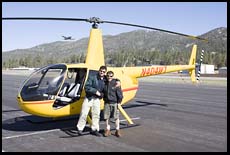
Robinson R44 Raven I
an owner's review by Philip Greenspun, ATP-CFII; revised October 2020

|
Robinson R44 Raven Ian owner's review by Philip Greenspun, ATP-CFII; revised October 2020 |

|
Within its price range, Robinson's R44 is probably the best helicopter in the world for personal ownership and it might also be the best helicopter for primary training. The R44 Raven I carries a base list price of $412,000, with dealers typically discounting 3 or 4 percent off list. Paying close to $5 per gallon for 100LL and budgeting realistic amounts for maintenance and the 2200-hour overhaul, the direct operating cost of an R44 is approximately $225 per hour.
Robinson helicopters are remarkably reliable and maintenance-free. The majority of accidents are due to pilot error, so the accident and death rates in Robinson machines would be tough to reduce by making the machine more robust (though we'll talk later about some engineering improvements that could make accidents less likely to occur and more survivable).
At a production rate that peaked at 800 machines per year, aggregating R22 and R44 sales, Robinson makes more helicopters than the rest of the manufacturers combined (even the military doesn't operate all that many helicopters; the U.S. Army's Sikorsky Blackhawk fleet, for example, is only about 1200 machines accumulated since 1978). The company produced its 12,000th helicopter in January 2017.
Light weight (2400 lbs. max gross for the Raven I; 2500 for the Raven II). The R44 doesn't have a lot of inertia. If you put in a control input, the helicopter responds immediately and dramatically. A heavier helicopter is going to respond more gradually. The R44 is like a sports sedan; the big turbine helicopters are like trucks.
Heavy weight. The R44 is substantially heavier than the R22 and therefore rides through wind gusts and turbulence much more solidly than the R22. A passenger who gets uncomfortable or sick in the R22 would have no problem on most days in the R44.
Piston power. If you weigh 500 lbs. and can leave the house only with the aid of a crane and a whale sling borrowed from the local public aquarium, by all means a 1200 horsepower turbine engine is the right power source for your personal helicopter. If, on the other hand, you are a person of normal weight, the piston engine provides instant power changes without the spool-up time of a turbine. Instant power is very comforting during a go-around. Another nice thing about the piston engine is that an R44 will burn about half as much fuel as a small turbine-powered helicopter, e.g., the Bell JetRanger.
Simple maintenance and overhaul. In theory, you don't have to hire a full-time mechanic to keep the R44 in the air and make sure that all of the components are overhauled on time. Aside from oil changes, nothing in the R44 requires service between 100-hour inspections. Almost everything in the R44 is overhauled at the 2200-hour interval. (see "maintenance examples" below for how it has worked for us in practice)
The Amsafe airbag seatbelts that became standard equipment starting in 2006 in most fixed wing aircraft (e.g., all Cirrus and Cessna piston singles) are not available for any helicopters, including the 505. The various research projects run by NASA and the military for under-helicopter airbags remain research projects. Thus occupants are primarily protected by the skids and seats to absorb energy in a vertical direction.
Robinson offers reasonably modern glass instrument panels, e.g., the Garmin G500H. This can be a safety improvement due to the propensity of mechanical gyros to fail when installed in the high-vibration environment of a helicopter. Robinson offers an autopilot as a factory option. This certainly could be nice in the event of inadvertent IMC or simply to take one's hands off the controls to adjust something.
The "Safety Tips and Notices" section at the end of the POH is a good catalog of problems that pilots have had (well, mostly created).
I decided to buy an R44 Raven I because we are using it primarily for flight training. The extra cost of a Raven II would have driven up our insurance cost and therefore we would have had to charge students more. The fact that the fuel-injected engine has been known to quit after a throttle chop, though supposedly fixed in more recent Raven IIs, was also a factor in leading us to choose a Raven I for flight training. It would be nice to have the A/C!
R44 Raven I R44 Raven II Price $412,000 $490,000 Power Carbureted Lycoming O-540 Fuel-injected Lycoming IO-540 Electrical System 14V older/28V newer 28V Gross Weight 2400 lbs. 2500 lbs. Empty Weight 1430 lbs. (stripped) 1500 lbs. minimum (?) Fuel Burn in Cruise 14 gallons/hour 15 gallons per hour Carb Icing Semi-automatic system to add carb heat No worries High Altitude Good Performance Very Good Performance Over Water Fixed Floats Optional Fixed or Pop-Out Floats Optional Air Conditioning Student Holds Spritzer Bottle Optional (33 lbs.; $21,500) Practice Autorotations Engine Idles Nicely 1970s fuel injection design may quit if you roll all the way down
 Passenger and baggage capacity with a full 49 gallons of fuel is a
remarkable 700 pounds in my stripped R44 Raven I, which has an empty
weight of 1430 lbs. The Raven II offers another 50 lbs. of payload, but
most owners use that up with options such as air conditioning and
pop-out floats. Baggage is stored underneath the seats. The crushability
of the seats is one of your primary protections in the event of a crash.
People have broken their backs in accidents that they might have walked
away from if they had simply avoided putting rigid non-crushable items
underneath their seat. If you're going to carry the wheels, for
example, keep one under each seat and make sure that the steel handle is
flat.
Passenger and baggage capacity with a full 49 gallons of fuel is a
remarkable 700 pounds in my stripped R44 Raven I, which has an empty
weight of 1430 lbs. The Raven II offers another 50 lbs. of payload, but
most owners use that up with options such as air conditioning and
pop-out floats. Baggage is stored underneath the seats. The crushability
of the seats is one of your primary protections in the event of a crash.
People have broken their backs in accidents that they might have walked
away from if they had simply avoided putting rigid non-crushable items
underneath their seat. If you're going to carry the wheels, for
example, keep one under each seat and make sure that the steel handle is
flat.
Get up on a ladder every now and then and look at the blades. The latest blade design, which has a very thin stainless steel skin, is quite fragile. One of our local pilots experienced substantial damage to an R44 blade that encountered an empty plastic water bottle. Another experience slight indentations after some slope work in which the blade whipped through some tall grass.
Aside from the items on the factory checklist, pay some attention to the little screws on the sheet metal around the doors. These screws have a way of coming out. Look for damage to the sheet metal surrounding the rotor mast, which would be a sign of a hard landing.
Starting the Raven I engine is reasonably easy, one of the advantages of carburetion. As the overnight temperature in the hangar drops to 50 degrees F and the air is cold (around freezing) outside, it becomes difficult to start, much more so than our R22. Applying a propane heater to the area around the carburetor enables an immediate start, however. If you don't have a flight school van with propane heater handy, an investment in a Reiff or Tanis electric preheater would be wise.
At 500 hours, our R44 began to make some ugly-sounding noises when we
attempted to start it. At the 100-hour inspection, the mechanics found
broken teeth on the ring gear (engine side) and on the B&C brand
starter. The most likely explanation is that someone tried to start our
R44, it failed to catch, and then they tried again without waiting long
enough for the starter motor to stop spinning. Apparently the B&C
starter will spin freely for some time after the engine has stopped
turning. In some military training environments, cadets are required to
remove their hands from the ignition key and touch the back of their
heads before putting their hands back on the key to crank again.
 If you look at the height-velocity diagram ("dead-man's curve") in the
R44 P.O.H., you'll notice that Robinson emphasizes a line drawn
approximately 10 feet above ground level. Nobody has demonstrated a
successful autorotation, one that does not break the ship, much above
10' and slower than 45 knots. A Jet Ranger pilot might begin lifting
the ship at around 30 knots. This works because there is so much more
inertia in the rotor system. If it feels unsafe to fly so fast so low,
keep in mind that if the engine quits, the ship will supposedly balloon
upward at first. You will be sinking from more like 20' than 10' and
will therefore have more time to execute a flare.
If you look at the height-velocity diagram ("dead-man's curve") in the
R44 P.O.H., you'll notice that Robinson emphasizes a line drawn
approximately 10 feet above ground level. Nobody has demonstrated a
successful autorotation, one that does not break the ship, much above
10' and slower than 45 knots. A Jet Ranger pilot might begin lifting
the ship at around 30 knots. This works because there is so much more
inertia in the rotor system. If it feels unsafe to fly so fast so low,
keep in mind that if the engine quits, the ship will supposedly balloon
upward at first. You will be sinking from more like 20' than 10' and
will therefore have more time to execute a flare.
Once you reach the magic 45 knots, let the ship rise into a 60-knot attitude and hold it there. Eventually you will achieve 60 knots and the ship will be climbing almost as fast as at Vy (55 knots). When you're a few hundred feet off the ground, say "upwind check" to yourself. Check those engine gauges. Look at the carb air temp gauge. If it is in the yellow, this is a good time to add carb heat. In fact, if you don't need the machine's full performance you can apply full carb heat and leave it on for the entire flight.
If you're doing a maximum performance takeoff over an obstacle, compare the rotor disk to the obstacle. If the tree is under the front of the rotor disk, you're probably going to make it. If you are looking through the spinning blades at the top of the tree, well, I hope that it is winter, that you are light, and that you are prepared to back up into your parking spot and kick your fat friends (and their dog) out of the ship before trying again.
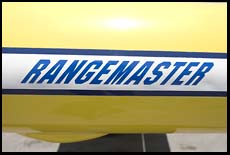 The R44 has a comfortable upright seating position. I find the R44
more comfortable than my Cirrus SR20
airplane and much more comfortable than the seats in a lot of
other light airplanes. The seatback angle is a lot like what you'd
find in a dining chair and the padding is cushy, typically tough to
achieve in conjuction with FAR 27 crashworthiness standards. The Bell
505 JetRanger seats are bolt-upright by comparison.
The R44 has a comfortable upright seating position. I find the R44
more comfortable than my Cirrus SR20
airplane and much more comfortable than the seats in a lot of
other light airplanes. The seatback angle is a lot like what you'd
find in a dining chair and the padding is cushy, typically tough to
achieve in conjuction with FAR 27 crashworthiness standards. The Bell
505 JetRanger seats are bolt-upright by comparison.
[The key to being comfortable during a long helicopter trip is to remind yourself to sit up straight. Don't lean forward or into the center of the helicopter.]
Heat is ample and uniformly distributed throughout the cabin. The fresh air supply is good, but very noisy, adding roughly 3 dBA at higher cruise speeds. We try to get by using the little vent windows cut into the doors and, if that isn't enough, removing a door. The noise of the fresh air system is actually audible over the noise of an open door.
The R44 rides through turbulence much more comfortably than an R22 and more comfortably than an airplane of comparable weight. The hydraulically boosted cyclic of the R44 doesn't vibrate in your hand the way that the R22's cyclic does.
Interior noise is comparable to a light airplane such as a Cessna 172, i.e., loud enough that you definitely need hearing protection. The R44 is actually quieter inside than some turbine-powered helicopters, e.g., the Eurocopter EC120.
Noise measurements from N808WT, an R-44 Raven I with just over 4400 hours on the clock, turned up the following numbers on a $200 Extech meter:
After 2.5 hours at a cruising speed of 110-120 knots, depending on
weight, you'll notice the fuel gauges near the quarter tank mark that
indicates approximately 30 minutes remaining. This makes the R44 Raven I
good for a 250 nautical mile trip against an average headwind.
 Pull the carb heat full up on downwind. The air outside might be above
freezing. The air speeds up and therefore cools down as it goes through
the carburetor venturi. If you close the throttle, as you would by
lowering collective on an approach to landing, you're creating an
additional venturi on either side of the throttle. You can get ice here
and the airflow to the engine will cease. Why doesn't this happen in
airplanes? It does, but the airplane has the windmilling propeller out
front to keep the engine turning. As soon as you open the throttle
again, the engine will start burning air and fuel again. Not so on the
helicopter. The sprag clutch prevents the spinning rotor system from
trying to turn the engine over. When the engine quits, it isn't coming
back until you turn it over with the starter motor.
Pull the carb heat full up on downwind. The air outside might be above
freezing. The air speeds up and therefore cools down as it goes through
the carburetor venturi. If you close the throttle, as you would by
lowering collective on an approach to landing, you're creating an
additional venturi on either side of the throttle. You can get ice here
and the airflow to the engine will cease. Why doesn't this happen in
airplanes? It does, but the airplane has the windmilling propeller out
front to keep the engine turning. As soon as you open the throttle
again, the engine will start burning air and fuel again. Not so on the
helicopter. The sprag clutch prevents the spinning rotor system from
trying to turn the engine over. When the engine quits, it isn't coming
back until you turn it over with the starter motor.
For a normal approach, cruise along at 300' AGL and 60 knots until the desired landing spot is just above the yaw string (this is about a 10-degree glide slope for a 6' tall pilot). Then smartly lower collective to begin a descent and adjust the collective to hold that spot at the same height on the bubble. Gradually pull back on the cyclic to keep the apparent rush of the ground underneath you constant. Make sure to establish a fairly aggressive descent rate of perhaps 700 fpm at first. Otherwise your approach will get too steep and you'll need a high descent rate towards the end, when you are slow. As you start to slow down and feel the vibrations from loss of effective translational lift (ETL), glance at the vertical speed indicator to make sure that you aren't descending more than 300 fpm. If you are, do not slow down below ETL or you are risking settling with power ("vortex ring state"). You probably did a settling with power demonstration up at 3000' with an instructor. In real life, you get into it about 100' above the ground while trying to do an approach.
If you're going into a confined area and might need the last bit of power, push the carb heat down as soon as you commit to the landing, perhaps 50-100' above the ground.
 If it is ridiculously windy, you might not want to leave the R44
pointing directly into the wind, though most people do. The blades will
flap more as they slow down when you shut down. There is some risk that
they will get pushed back by the wind and contact the tail boom. Better
to park the ship so that the wind is coming from the right side as you
shut down.
If it is ridiculously windy, you might not want to leave the R44
pointing directly into the wind, though most people do. The blades will
flap more as they slow down when you shut down. There is some risk that
they will get pushed back by the wind and contact the tail boom. Better
to park the ship so that the wind is coming from the right side as you
shut down.
If there is any chance that another helicopter might park or lift off nearby, secure at least the front rotor blade with the tiedown.
If you're keeping the R44 in a hangar, do not leave the helicopter up on the Robinson-supplied ground handling wheels. The tires are designed for occasional usage, not continuous weight-bearing. For easier one-person ground handling over smooth surfaces, consider solid wheels, which reduce the pushing effort required. Helicopter Easy Wheels have some fans, but make sure that you get the heavy duty blue wheels and not the original black rubber. Damage to the rubber requires cracking the wheel off the handle with a hydraulic press and replacing the entire wheel.
Helitowcart makes a broad range of ground handling equipment, including some basic single wheels that come apart and can be stored under the seat. These have the advantage of easy serviceability. A wheel comes off with a socket wrench in 30 seconds, for example. Helitowcart offers a rigid wheel for easier pushing, a gel-filled tire for people who don't mind the extra weight and don't want to pump up the tires monthly, and a conventional tube/tire arrangement. These have a rotating pin that fits into the skids, which means the skid attach point shouldn't wear out as it typically does with the factory wheels. If the tube fails, that's a $20 part. Tire fails? A $40 Kenda that can be sourced from many different vendors. Over hangar tracks or rough ground, the regular air-filled tires might be the best choice. For more aggravated situations, such as moving a helicopter on grass, people seem to like the Helitowcart dual-wheel solution. (One owner talked about a dual wheel system from Brackett Aircraft: "Heavy as hell but absolutely bulletproof."; they are spec'd as weighing 22 lbs. each)
Nearly all owners spoke highly of support and service from Helitowcart.
We bought the Robinson Helicopter towcart. It cost $7,000, failed after two uses, required days of our (brilliant) mechanic's labor to fix, and was not supported with any troubleshooting guide or wiring diagram. Nor was it covered by any labor warranty. (As of 2020, the tow cart is $9,600) The Helitowcart V201 is quite a bit cheaper, adapts for use with other light helicopters such as the A Star, the Jet Ranger, etc., and is popular with owners. The Helitowcart product has the advantage of using standard marine deep-cycle batteries that can be purchased inexpensively anywhere; the Robinson tow cart actually uses aviation batteries(!).
I recommend against ordering any gyros in the R44. They are heavy, expensive, and tend only to last 500 hours when subjected to the vibration of a helicopter. At the safety course, Frank Robinson himself noted that he has been disappointed in the number of R44s with attitude indicators and Garmin 430s that have flown into instrument meteorological conditions (IMC) and not come out. The extra capability does not translate into safety, apparently, but only encourages pilots to take risks with the weather that they should not have. As noted in the Instrument Training section below, one day there will be lightweight glass panels with solid-state attitude reference that will fit into the R44.
I recommend against the optional digital clock. The timer is nice, but the instrument has spectacularly crummy buttons that tend to stop working reliably. You never can be sure whether or not you have been successful in starting the timer.
The one option that we ordered in our first R44 Raven I was a vertical card compass. We then used a Garmin portable GPS for navigation, obstacle warnings, and terrain warnings. The Garmin is mounted with a suction cup to the bubble. It shakes quite a bit and can be hard to read if you don't stabilize it with your knee. In this day and age it is probably better to run an iPad Mini and an app that links to the ADS-B transponder for weather, traffic, etc.
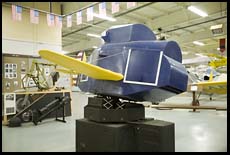 The R44 can be ordered with a full set of steam gauges for instrument
training and is wonderfully stable. As a reasonably current airplane
instrument pilot, low-time helicopter pilot, and no-time R44 pilot, I
was able to fly an ILS approach down to minimums on my first try under
the hood in an R44.
The R44 can be ordered with a full set of steam gauges for instrument
training and is wonderfully stable. As a reasonably current airplane
instrument pilot, low-time helicopter pilot, and no-time R44 pilot, I
was able to fly an ILS approach down to minimums on my first try under
the hood in an R44.
Given the weight and unreliability of mechanical gyros when subjected
to the vibrations of a helicopter, it might be worth looking into
aftermarket installation of instruments such as the Garmin GI
275. Robinson offers Aspen as a factory option and also the Garmin
G500H. Owners have had bad experiences with Aspen for
reliability. None of these glass options work that well in the
Robinson. They were designed for airplanes, in which the panel is just
a short distance from the pilot's eyes. They're difficult to read in a
farther-away Robinson panel.
 Most helicopters have two massive cyclic sticks poking up from the floor
in front of the pilot seats. The Robinson has a cyclic coming up from
the center of the ship with horizontal arms at the top. If the left
side arm is attached, either pilot can apply pressure to the cyclic at
any time.
Most helicopters have two massive cyclic sticks poking up from the floor
in front of the pilot seats. The Robinson has a cyclic coming up from
the center of the ship with horizontal arms at the top. If the left
side arm is attached, either pilot can apply pressure to the cyclic at
any time.
One downside of the T-bar cyclic is that, even with the left side controls removed, the actual cyclic is very close to a passenger's right leg and right arm. A passenger is much more likely to nudge the cyclic accidentally than he or she would be in a Jet Ranger. A more serious problem is that a passenger might intentionally yank on the cyclic. Social conventions and the wide cockpit would probably prevent a passenger from reaching down between your legs and grabbing the pilot's side Jet Ranger cyclic. A local flight school owner was giving rides at a county fair in an R44. One strong young teenager, when they were in a hover at the very end of the 6-minute ride, grabbed the top of the T-bar and shook it, asking "what does this do?" Fortunately he learned the answer before the helicopter rolled over... Consider adding a "this is the control that rolls the helicopter over if you touch it" line to your preflight passenger briefing.
The R44's long range and practicality for cross-country trips make the T-bar cyclic perhaps more dangerous than in the R22. On a long trip people get a little bored. They start talking. When the non-flying person is talking, he or she is likely to be gesturing. A gesturing person will frequently whack their portion of the T-bar or the cyclic tube itself. If the flying pilot doesn't have a firm grip on the controls, there is a possibility of the cyclic being pushed full forward, which might lead to a low-G situation, an improper full left cyclic input, and mast bumping.
I have encountered high-time Robinson pilots who've been scared more than once by accidental knocks to the T-bar and wish that the R44 had conventional low-and-between-the-legs cyclic controls.
Robinson offers a variety of GPS units as factory-installed options. Unfortunately, these are generally placed in a hard-to-see place at the bottom of the radio stack and pricing begins at about $20,000. A kneeboard-mounted portable GPS or tablet is likely more capable for VFR flying. Note that, as of 2020, Garmin has a "new panel" that can accommodate a Garmin 600-series GPS/COM up closer to the round dials. Including the GPS and the required audio panel, this will cost about the same as 200 years of subscribing to ForeFlight (i.e., $20,000).
 Robinsons now seem to come from the factory pre-wired with LEMO
("Bose-style") connectors as well as the standard helicopter headset
jacks.
Robinsons now seem to come from the factory pre-wired with LEMO
("Bose-style") connectors as well as the standard helicopter headset
jacks.
On our older Raven Is for flight school use, we picked the David Clark
H10-56HXL, the most rugged noise-cancelling headset available and has
a coiled cord for helicopter use. David Clark uses a Hirosi connector
and can only accept 14V, so our after-market Hirosi installation
wouldn't work with the latest Raven Is.
 Robinson uses a Lycoming O-540 engine in the R44 Raven I. The internal
geometry and compressions of this engine are identical to a
260-horsepower engine for an airplane. The continuous power limit on
the helicopter is 205 horsepower (78 percent), partly for engine life
but also because that's what the transmissions and driveshafts are
engineered to take. You are allowed to draw 225 horsepower for up to
five minutes.
Robinson uses a Lycoming O-540 engine in the R44 Raven I. The internal
geometry and compressions of this engine are identical to a
260-horsepower engine for an airplane. The continuous power limit on
the helicopter is 205 horsepower (78 percent), partly for engine life
but also because that's what the transmissions and driveshafts are
engineered to take. You are allowed to draw 225 horsepower for up to
five minutes.
How much power is actually available at sea level? 260 horsepower. The collective control in your left hand is mechanically connected to the swashplate, which will push up the pitch links until the blades assume an extreme pitch angle. The correlator and governor will open the throttle as wide as it needs to go in order to keep the blades spinning at 400 rpm. If you load up the helicopter with lead and pull the collective up into your armpit, the engine will put out 260 horsepower in an attempt to keep those blades from slowing down against air resistance.
With just two people in the R44 for training, it would be almost
inconceivable to exceed the published manifold pressure limit. On a hot
day at gross weight coming out of a confined area, you might go over the
red line. There is no required inspection after such an exceedance, but
prolonged operations at higher-than-authorized power settings invites
catastrophic mechanical failure.
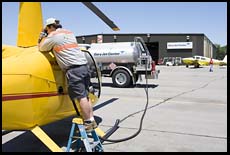 The R44 burns 100 low-lead Avgas. For the Raven I, an STC is
available for mogas. The number one reason for airplane piston engines
to stop running is fuel exhaustion, i.e., the pilot failing to plan
properly. The R44 has two fuel gauges, one for the aux and one for
the main tank; there is no way to switch between tanks and it would be
nice if these quantities were electrically combined to reduce pilot
workload. The R44 has a separate low fuel warning system that is
entirely separate from the gauges. The low fuel light comes on when
you have about ten minutes of fuel remaining.
The R44 burns 100 low-lead Avgas. For the Raven I, an STC is
available for mogas. The number one reason for airplane piston engines
to stop running is fuel exhaustion, i.e., the pilot failing to plan
properly. The R44 has two fuel gauges, one for the aux and one for
the main tank; there is no way to switch between tanks and it would be
nice if these quantities were electrically combined to reduce pilot
workload. The R44 has a separate low fuel warning system that is
entirely separate from the gauges. The low fuel light comes on when
you have about ten minutes of fuel remaining.
At the Robinson Factory Safety Course, we were told not to rely on the gauges: "Use your watch," the instructor said, suggesting that we keep track of flight time. "How many gallons per hour does the R22 burn?" a student asked, noting that there are no data for fuel consumption or range in the P.O.H. (the same is true for the R44 P.O.H.). "We won't tell you that because it might not be right for your ship," was the reply. "What about a dipstick?" None is supplied. So... you don't really know how much fuel is in the tanks unless you top off and are way over gross. You could make your own fuel stick, but where do you store it so that you don't get grit on it and then put grit into the fuel tanks? Even if you knew how much fuel was in the tanks before you took off, it would be tough to calculate how much remained in flight because you don't have any numbers for fuel consumption.
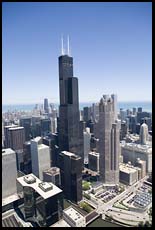 The panel-mount Garmin GPS units offer a terrain page, which can be
upgraded to full HTAWS via a Garmin software tweak. The G500H glass
panel that is available from the factory has a synthetic terrain
option.
The panel-mount Garmin GPS units offer a terrain page, which can be
upgraded to full HTAWS via a Garmin software tweak. The G500H glass
panel that is available from the factory has a synthetic terrain
option.
For compliance with FAR 135.160, Robinson will add in a radar altimeter for $20,000.
Kneeboard iPad apps, such as ForeFlight, will also warn you of
impending terrain conflicts.
 The R44 has the same lighting posts around the panel that you'd find in
an old Piper. They are reasonably effective and consistent. You switch
them on by turning on the nav lights.
The R44 has the same lighting posts around the panel that you'd find in
an old Piper. They are reasonably effective and consistent. You switch
them on by turning on the nav lights.
If you're operating in a truly dark area, i.e., not a towered airport, consider leaving the landing light off when near the ground. It is so bright that it will ruin your night vision and you won't be able to distinguish between trees and sky. It is perfectly possible to hover using only the nav lights for reference.
Try to limit your night flying to familiar areas, following highways, well-lit cities, and higher-than-usual altitudes above the ground. Even some very experienced crews have gotten disoriented and collided with terrain or water at night. In an airplane, I treat a night flight in an unfamiliar or mountainous area as an instrument flight and fly IFR routes, altitudes, and procedures.
Don't try to take off unless you can hover. Don't get anywhere near the limits of the R44's performance unless you are going from one big airport to another big airport where there is plenty of room to slide onto a runway. When approaching to land, don't let your airspeed fall below ETL unless everything looks good. Don't go into any confined area unless the P.O.H. says that you can do an out-of-ground-effect hover at that altitude.
How does the Raven I do in practice? On my first full day of ownership,
we filled up the tanks and put three guys in the cabin and went up to
Big Bear, California, an airport at 6700' above sea level that was 8600'
density altitude due to hot summer weather. At an estimated weight of
2250 lbs., i.e., 150 under gross, we had plenty of power for our
approach to an in-ground-effect hover. We also had a good 500' per
minute climb rate out of there. At 2200 lbs., I have had no difficulty
landing the R44 Raven I at airports as high as 7400' and have even done
some pinnacle landings closer to 8000' above sea level.
 Unlike a Jet Ranger, the R44 does not have any little photo windows
that can be opened far enough to stick a lens out. You have to take
the entire door off, which makes the standard machine impractical for
aerial photography except in warm climates. A company called
Tech-Tool has an STC'd door (about $5000 including crating and
shipping) for with a sliding window. There are versions for both the
R22 and R44. Robinson hates to see anything not from the factory
attached to their ships and Pathfinder insurance excludes coverage for
any accident due to, say, a chunk of the Tech Tool door coming off and
hitting the tail rotor. We bought an R44 door from Tech-Tool in
September 2013. One of the most experienced airframe mechanics in New
England couldn't get it to fit, not even with the help of a complete
flight school maintenance department that had just completed two
overhauls on R44s and that included mechanics with 30-40 years of
helicopter experience (including 30+ with Robinsons). We shipped it
back to Tech-Tool and Sharon Crager responded with "we're not able to
find a structural reason for the fit problem" and "our recommendation
is to locate a Robinson-experienced A&P mechanic to finish the job."
Due to Tech-Tool's blame-the-local-mechanic approach, the door was
still not installed as of November 2014.
Unlike a Jet Ranger, the R44 does not have any little photo windows
that can be opened far enough to stick a lens out. You have to take
the entire door off, which makes the standard machine impractical for
aerial photography except in warm climates. A company called
Tech-Tool has an STC'd door (about $5000 including crating and
shipping) for with a sliding window. There are versions for both the
R22 and R44. Robinson hates to see anything not from the factory
attached to their ships and Pathfinder insurance excludes coverage for
any accident due to, say, a chunk of the Tech Tool door coming off and
hitting the tail rotor. We bought an R44 door from Tech-Tool in
September 2013. One of the most experienced airframe mechanics in New
England couldn't get it to fit, not even with the help of a complete
flight school maintenance department that had just completed two
overhauls on R44s and that included mechanics with 30-40 years of
helicopter experience (including 30+ with Robinsons). We shipped it
back to Tech-Tool and Sharon Crager responded with "we're not able to
find a structural reason for the fit problem" and "our recommendation
is to locate a Robinson-experienced A&P mechanic to finish the job."
Due to Tech-Tool's blame-the-local-mechanic approach, the door was
still not installed as of November 2014.
People have had accidents from windows popping out and doors not being properly secured. So if you are putting doors on and off, don't get lazy about putting the cotter pins back through the hinges.
Most of the standard insurance companies will not insure Robinson helicopters, partly due to the fact that Robinson does not itself have insurance. Thus if there is an accident and the victims allege that there was a manufacturing or design defect, the owner's insurance company is defending side-by-side with the notoriously stubborn Robinson and not with a settlement-minded insurance company.
Sutton James has a program underwritten Starr Aviation. The insurance can cover customer rental, flight training, FAR 135 operations, etc. We get our insurance through David Hampson, who is a great agent (handles a lot of turboprops and jets, but is also competent with piston aircraft).
 Unlike other brands of helicopters, where each component has its own
life limits and you'd better hope that your mechanic is extremely
organized with his or her record-keeping, the R44 basically has one
big limit: 2200 hours or 12 years. When you reach that point, the
ship must be overhauled. You can send it back to the factory and they
will bring it back to nearly new condition inside and out (5-9 months
later), or you can buy an overhaul kit and have your mechanic do the
work. The latter option is a little less expensive, but the ship will
not be cosmetically restored.
Unlike other brands of helicopters, where each component has its own
life limits and you'd better hope that your mechanic is extremely
organized with his or her record-keeping, the R44 basically has one
big limit: 2200 hours or 12 years. When you reach that point, the
ship must be overhauled. You can send it back to the factory and they
will bring it back to nearly new condition inside and out (5-9 months
later), or you can buy an overhaul kit and have your mechanic do the
work. The latter option is a little less expensive, but the ship will
not be cosmetically restored.
The cost of overhaul is substantially higher than Robinson advertises due to the fact that Robinson adds a substantial core charge to the cost of an overhaul kit. When the timed-out cores are returned to the factory, nearly always the factory says "These cores are in much worse than average condition" and only a portion of the core charge is refunded. A factory overhaul can cost $250,000 to $300,000 ($136/hour). The tailcone and a few other components have a life limit of 4400 hours, so the 2nd, 4th, 6th, etc. overhauls are about $15,000 more expensive than the odd-numbered overhauls.
If a major component fails before 2200 hours, you end up with a machine that has out of sync parts. For example, at 2107 collective hours, the main rotor transmission gears on one of our helicopters began grinding and produced enough metal to activate the MR CHIP light. We already had an overhaul kit in place and elected to swap the transmission. So we were left with a helicopter whose transmission required replacement at 4307 hours while the rest of the machine required overhaul at 4400 hours.
Budget $50 per hour for 100-hour inspections and other routine maintenance.
Here are some of my favorite dealers:
One caveat about the Robinsons these days is that if you get some few options you might find that the cost goes up to the point that a used EC120 is actually cheaper. The Garmin 420W GPS/COM that we paid about $5,000 extra for in a 2008 machine is now lightly upgraded to a touch screen and will cost close to $20,000 with the required audio panel.